#Cloud Computing in Switzerland
Explore tagged Tumblr posts
Text
In today's dynamic business landscape, where agility, scalability, and security are paramount, the demand for robust hosting solutions has surged exponentially.
1 note
·
View note
Photo

Phd or Postdoc in Switzerland for International Students: On Swiss Government Excellence Scholarships
This is a short preview of the article: Do you have a fresh master or PhD and are you considering Phd or Postdoc in Switzerland? The Swiss Government Excellence Scholarship offers young researchers from around the world who have completed a master’s degree or PhD the opportunity to start or continue their research careers in S
If you like it consider checking out the full version of the post at: Phd or Postdoc in Switzerland for International Students: On Swiss Government Excellence Scholarships
If you are looking for ideas for tweet or re-blog this post you may want to consider the following hashtags:
Hashtags: #BigData, #CloudComputing, #DigitalDecisionMaking, #DistributedSystems, #Fellowship, #HumanBehaviourInformatics, #InternetOfThings, #IoT, #PhD, #PostDoc, #ServiceOrientedArchitecture, #Swiss, #Switzerland, #VirtualReality
The Hashtags of the Categories are: #BigData, #CloudComputing, #InternetofThings, #Job, #Job/Fellowship, #MachineLearning, #Programming, #Research, #SoftwareEngineering
Phd or Postdoc in Switzerland for International Students: On Swiss Government Excellence Scholarships is available at the following link: https://francescolelli.info/job/phd-or-postdoc-in-switzerland-for-international-students-on-swiss-government-excellence-scholarships/ You will find more information, stories, examples, data, opinions and scientific papers as part of a collection of articles about Information Management, Computer Science, Economics, Finance and More.
The title of the full article is: Phd or Postdoc in Switzerland for International Students: On Swiss Government Excellence Scholarships
It belong to the following categories: Big Data, Cloud Computing, Internet of Things, Job, Job/Fellowship, Machine Learning, Programming, Research, Software Engineering
The most relevant keywords are: Big Data, Cloud Computing, Digital Decision Making, Distributed Systems, fellowship, Human Behaviour Informatics, internet of things, IoT, PhD, Post-Doc, Service Oriented Architecture, Swiss, Switzerland, Virtual Reality
It has been published by Francesco Lelli at Francesco Lelli a blog about Information Management, Computer Science, Finance, Economics and nearby ideas and opinions
Do you have a fresh master or PhD and are you considering Phd or Postdoc in Switzerland? The Swiss Government Excellence Scholarship offers young researchers from around the world who have completed a master’s degree or PhD the opportunity to start or continue their research careers in S
Hope you will find it interesting and that it will help you in your journey
Do you have a fresh master or PhD and are you considering Phd or Postdoc in Switzerland? The Swiss Government Excellence Scholarship offers young researchers from around the world who have completed a master’s degree or PhD the opportunity to start or continue their research careers in Switzerland. The scholarship supports research endeavors for a…
#Big Data#Cloud Computing#Digital Decision Making#Distributed Systems#fellowship#Human Behaviour Informatics#internet of things#IoT#PhD#Post-Doc#Service Oriented Architecture#Swiss#Switzerland#Virtual Reality
0 notes
Text
Why I remain hopeful about America
Even as darkness falls
ROBERT REICH
JAN 20

Friends,
So many people I know — including, I suspect, many of you — are despairing over Trump’s second regime, which starts today.
I share your fears about what’s to come.
Yet I remain hopeful about the future of America. Here’s why.
Trump hoodwinked average working Americans into believing he’s on their side and convinced enough voters that Kamala Harris and Democrats were on the side of cultural elites (the “deep state,” “woke”ism, “coastal elites,” and so on).
But Trump’s hoax will not work for long, given the oligarchy’s conspicuous takeover of America under Trump II.
Even before Trump’s regime begins, it’s already exposing a reality that has been hidden from most Americans for decades: the oligarchy’s obscene wealth and its use of that wealth to gain power over America.
Seated prominently where Trump is giving his inaugural address today will be the three richest people in America — Elon Musk, Jeff Bezos, and Mark Zuckerberg — each of whom owns powerful media that have either boosted Trump’s lies or refrained from telling the truth about him.
Musk sank a quarter of a billion dollars into getting Trump elected, in return for which Trump has authorized him, along with billionaire Vivek Ramaswamy, to target for elimination programs Americans depend on — thereby making way for another giant tax cut for the wealthy.
The oligarchy’s conflicts of interest will be just as conspicuous.
Musk’s SpaceX is a major federal contractor through its rocket launches and its internet service, Starlink. Bezos’s Amazon is a major federal contractor through its cloud computing business. Zuckerberg is pouring billions into artificial intelligence, as is Musk, in hopes of huge federal contracts.
Ramaswamy, whose biotech company is valued at nearly $600 million, wants the Food and Drug Administration to speed up drug approvals. His investment firm has an oil and gas fund. His new Bitcoin business would benefit if the federal government kept its hands off crypto.
Trump himself has already begun to cash in on his second presidency even more blatantly than he did the first time. He just began selling a cryptocurrency token featuring an image of himself — even though cryptocurrency is regulated by the Securities and Exchange Commission, to which Trump has already said he’ll name a crypto advocate as chair.
Not to mention the billionaires Trump is putting in charge of key departments to decide on taxes and expenditures, tariffs and trade, even what young Americans learn — all of whom have brazen conflicts of interest.
They’ll all be on display today with Trump. Then, many will take their private jets to Davos, Switzerland, for the annual confab of the world’s most powerful CEOs and billionaires.
Not since the Gilded Age of the late 19th century has such vast wealth turned itself into such conspicuous displays of political power. Unapologetically, unashamedly, defiantly.
This flagrancy makes me hopeful. Why? Because Americans don’t abide aristocracy. We were founded in revolt against unaccountable power and wealth. We will not tolerate this barefaced takeover.
The backlash will be stunning.
I cannot tell you precisely how or when it will occur, but it will start in our communities when we protect the most vulnerable from the cruelties of the Trump regime, ensure that hardworking families aren’t torn apart, protect transgender and LGBTQ+ people, and help guard the safety of Trump’s political enemies.
We will see the backlash in the 2026 midterms and the 2028 presidential election, when Americans elect true leaders who care about working people and the common good.
And just as we did at the end of the first Gilded Age of the late 19th century when the oligarchy revealed its hubris and grandiosity, Americans will demand fundamental reforms: getting big money out of politics, taxing huge wealth, busting up or regulating giant corporations, making huge social media platforms accountable to the public rather than to a handful of multibillionaires.
Friends, we could not remain on the path we were on. The sludge had been thickening even under Democratic administrations. Systematic flaws have remained unaddressed. Inequalities have continued to widen. Corruption and bribery have worsened.
It’s tragic that America had to come to this point. A few years of another Trump regime, even worse than the first, will be hard on many people.
But as the oligarchy is conspicuously exposed, Americans will see as clearly as we did at the end of the first Gilded Age that we have no option but to take back power.
Only then can we continue the essential work of America: the pursuit of equality and prosperity for the many, not the few. The preservation and strengthening of a government of, by, and for the people.
23 notes
·
View notes
Text
2024 team sponsors recap!
this is completely irrelevant to F1 but i study and do these stuffs for a living sooo 😩😩 2023 sponsors are based on the sponsors that are there at the beginning of the season (new sponsors that join in the middle of the season will be classified as 2024's)
Mercedes AMG Petronas F1 Team:
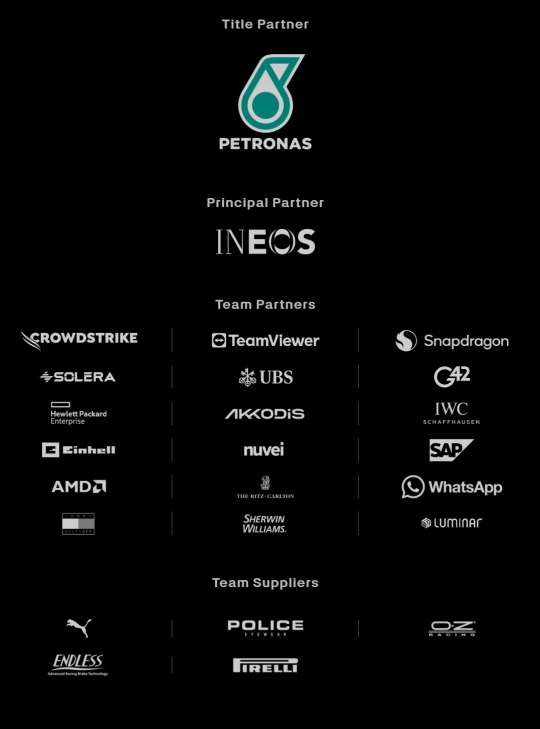
New sponsors: Whatsapp, Luminar (American tech company), SAP (German software company), nuvei (Canadian credit card services), Sherwin Williams (American painting company) 2024 data last update: 2024/02/14
Old sponsors that left: Monster Energy, Pure Storage (American technology company), fastly (American cloud computing services), Axalta (American painting company), Eight sleep (American mattresses company) 2023 data last update: 2023/01/07
Oracle Red Bull Racing F1 Team:
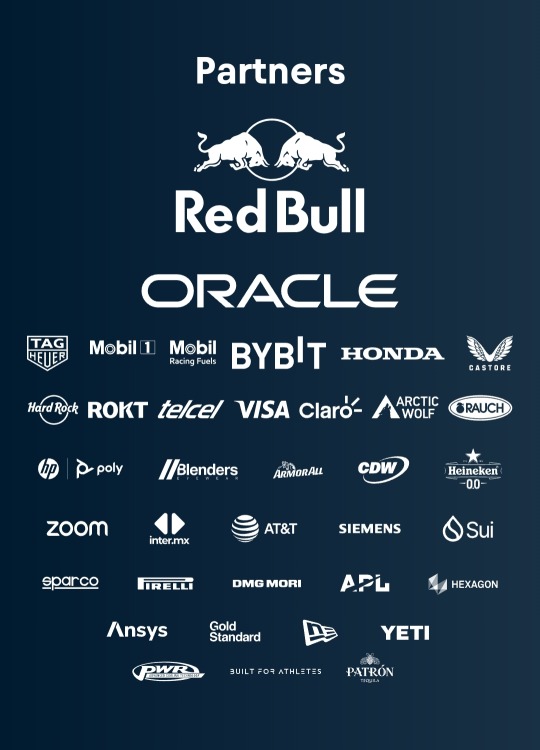
New sponsors: Yeti (American cooler manufacturer, joined later in 2023), APL (American footwear/athletic apparel manufacturer, joined later in 2023), CDW (American IT company, joined later in 2023), Sui (American tech app by Mysten Labs, joined later in 2023), Patron Tequila (Mexican alcoholic beverages company, joined later in 2023) 2024 data last update: 2024/02/15
Old sponsors that left: CashApp, Walmart, Therabody (American wellness technology company), Ocean Bottle (Norwegian reusable bottle manufacturer), PokerStars (Costa Rican gambling site), Alpha Tauri (? no info if they're official partners or not but Austrian clothing company made by Red Bull), BMC (Switzerland bicycle/cycling manufacturer), Esso (American fuel company, subsidiary of ExxonMobil), Hewlett Packard Enterprise (American technology company) 2023 data last update: 2023/03/07
More: Esso is a subsidiary of Mobil so there's possibility they merged or something
Scuderia Ferrari:
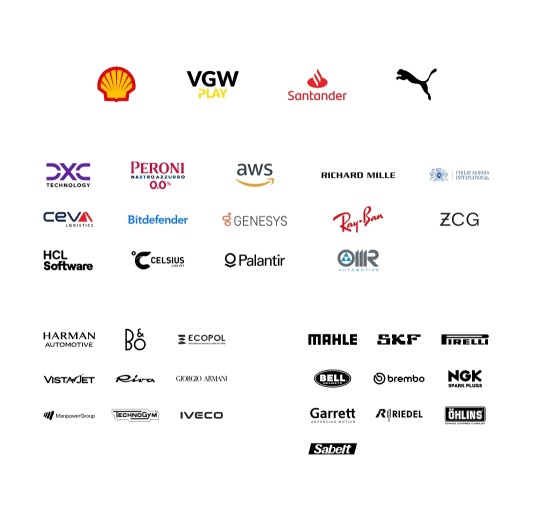
New sponsors: VGW Play (Australian tech game company, joined later in 2023), DXC Technology (American IT company, joined later in 2023), Peroni (Italian brewing company), Z Capital Group/ZCG (American private asset management/merchant bank company), Celsius (Swedish energy drink manufacturer) 2024 data last update: 2024/02/15
Old sponsors that left: Mission Winnow (American content lab by Phillip Morris International aka Marlboro), Estrella Garcia (Spanish alcoholic beverages manufacturer), Frecciarossa (Italian high speed train company) 2023 data last update: 2023/02/16
More: Mission Winnow is a part of Phillip Morris International. They are no longer listed as team sponsor but PMI is listed instead.
(starting here, 2023 data last update is 2023/02/23 and 2024 data last update is 2024/02/15)
McLaren F1 Team: (Only McLaren RACING's data is available idk if some of these are XE/FE team partners but anw..)
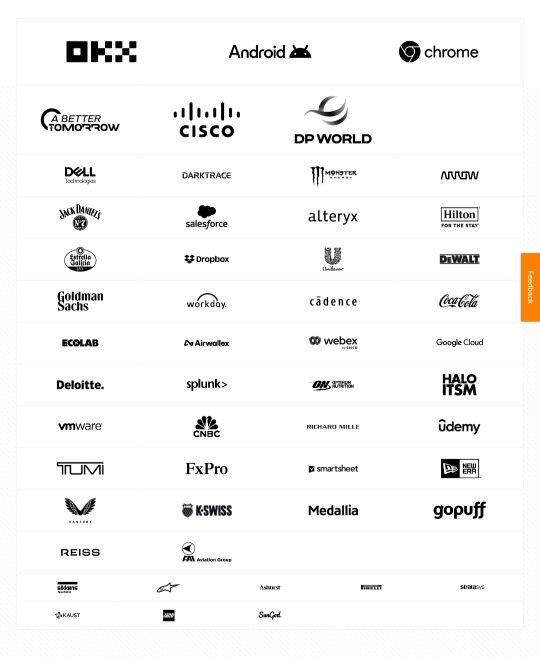
New sponsors: Monster Energy, Salesforce (American cloud based software company, joined later in 2023), Estrella Garcia (Spanish alcoholic beverages manufacturer), Dropbox (American file hosting company), Workday (American system software company, joined later in 2023), Ecolab (American water purification/hygiene company), Airwallex (Australian financial tech company), Optimum Nutrition (American nutritional supplement manufacturer), Halo ITSM (American software company, joined later in 2023), Udemy (American educational tech company, joined later in 2023), New Era (American cap manufacturer, joined in 2023), K-Swiss (American shoes manufacturer, joined later in 2023), Alpinestars (Italian motorsports safety equipment manufacturer)
Old sponsors that left: DP World (Emirati logistics company), EasyPost (American shipping API company), Immersive Labs (UK cybersecurity training company?), Logitech, Mind (UK mental health charity), PartyCasino (UK? online casino site), PartyPoker (American? gambling site), Sparco (Italian auto part & accessory manufacturer), Tezos (Switzerland crypto company)
Aston Martin Aramco F1 Team:

New sponsors: Valvoline (American retail automotives service company, joined later in 2023), NexGen (Canadian sustainable? fuel company), Banco Master (Brazilian digital banking platform, joined later in 2023), ServiceNow (American software company, joined later in 2023), Regent Seven Seas Cruise, Wolfgang Puck (Austrian-American chef and restaurant owner, joined later in 2023), Financial Times (British business newspaper), OMP (Italian racing safety equipment manufacturer), stichd (Netherlands fashion & apparel manufacturer)
Old sponsors that left: Alpinestars (Italian motorsports safety equipment manufacturer), crypto.com (Singaporean cryptocurrency company), ebb3 (UK? software company), Pelmark (UK fashion and apparel manufacturer), Peroni (Italian brewing company), Porto Seguro (Brazilian insurance company), Socios (Malta's blockchain-based platform), XP (Brazilian investment company)
Stake F1 Team (prev. Alfa Romeo):
???? Can't found their website (might be geoblocked in my country???)
BWT Alpine F1 Team:
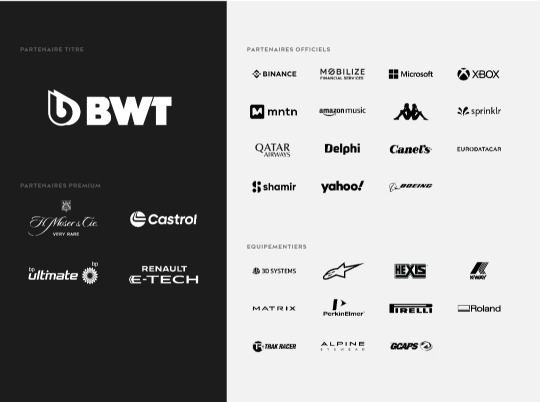
New sponsors: MNTN (American software company), H. Moser & Cie (Switzerland watch manufacturer), Amazon Music
Old sponsors that left: Bell & Ross (French watch company), Ecowatt (??? afaik French less-energy smthn smthn company), Elysium (French? American? Software company), KX (UK software company), Plug (American electrical equipment manufacturing company)
Visa CashApp RB F1 Team (prev. Scuderia Alpha Tauri):

New Sponsors: Visa, CashApp, Hugo Boss, Tudor, Neft Vodka (Austrian alcoholic beverages company), Piquadro (Italian luxury bag manufacturer)
Old sponsors that left: Buzz (?), Carl Friedrik (UK travel goods manufacturer), Flex Box (Hongkong? shipping containers manufacturer), GMG (Emirati global wellbeing company), RapidAPI (American API company)
Haas F1 Team:

New sponsors: New Era (American cap manufacturer, joined later in 2023)
Old sponsors that left: Hantec Markets (Hongkong capital markets company), OpenSea (American NFT/Crypto company)
Williams Racing:

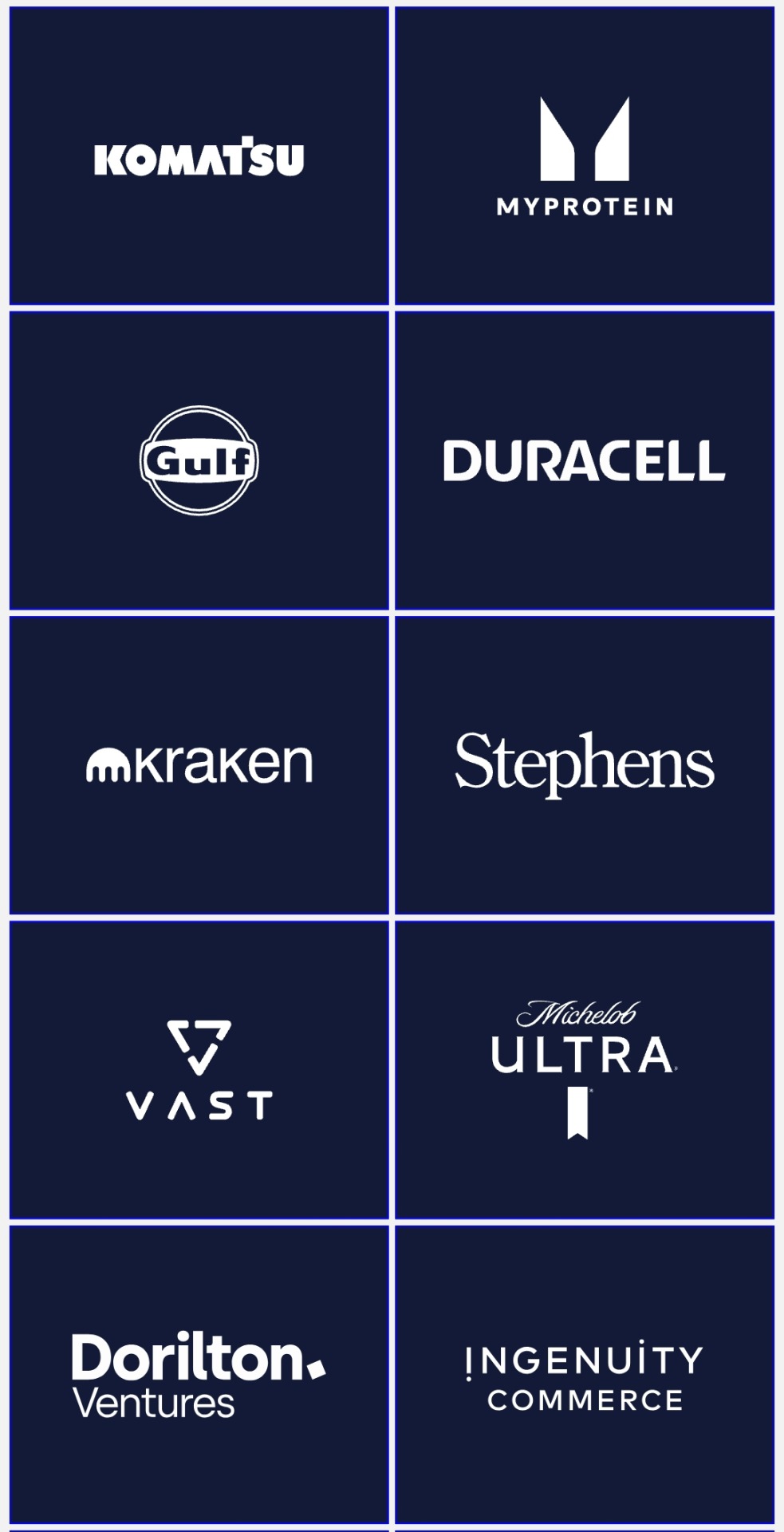
New sponsors: Komatsu, MyProtein (British bodybuilding supplement), Kraken (American crypto company, joined later in 2023), VAST Data (American tech company), Ingenuity Commerce (UK e-commerce platform), Puma (joined later in 2023)
Old sponsors that left: Acronis (Swiss software company), Bremont (British watch manufacturer), Dtex Systems (American? cybersecurity company), Financial Times (British business newspaper), Jumeirah Hotels & Resorts, KX (UK software company), OMP (Italian racing safety equipment manufacturer), PPG (American painting manufacturer), Umbro (English sports equipment manufacturer), Zeiss (German opticals/optometrics manufacturing company)
#mercedes amg petronas#red bull racing#scuderia ferrari#visa cash app rb#haas f1 team#mclaren f1#aston martin#alpine f1#williams racing#stake f1 team#f1#ari's rant#sponsor talks
42 notes
·
View notes
Text
Popular Courses Currently in Demand for International Students
@unilifeabroadcareersolutions

Popular courses currently in demand for international students After finding the perfect course, any international student must make another crucial decision when choosing which course to study abroad in. Global industries are currently changing fast, and it can create career opportunities for international students depending upon the fields they choose and the scope for Permanent Residency (PR). So here is a list of some of the top in-demand courses for international students looking to study abroad in 2024 and beyond. 1. Data Science and Artificial Intelligence
With the emergence of big data and AI-driven technologies, Data Science and AI have emerged as two of the most in-demand courses worldwide.
Why Choose It?
High-paying job opportunities. Demand in industries like IT, healthcare, finance, and retail. Courses available in countries like USA, Canada, Germany, and UK. Career Prospects: Data Scientist, AI Engineer, Machine Learning Expert, Data Analyst. 2. Engineering and Technology
Engineering is at the top preference of the international students due to a wide range of area and scope. Some of the most common specializations offered are Mechanical, Civil, Electrical, and Software Engineering.
Why to choose? All over the world, engineers are required for every industry, such as construction, automobile, and technological. Many colleges provide industrial training along with co-op programs. Top Destinations: Germany, Canada, Australia, and USA. Career Opportunities: Software Engineer, Project Manager, Structural Engineer, Robotics Specialized.
3. Business Administration and Management (MBA) A Master of Business Administration (MBA) is ideal for students who want to work in a leadership position or become an entrepreneur. There is a growing trend towards specialized MBAs in Finance, Marketing, Human Resources, and Operations. Why Choose It? International recognition and high-paying jobs. Networking opportunities and exposure to real-world business. Popular Places: USA, UK, Canada, and Australia. Career Paths: Business Consultant, Marketing Manager, Operations Director, Financial Analyst. 4. Healthcare and Nursing The health sector is on a roll due to the growing need for qualified professionals. Nursing, Public Health, Physiotherapy, and Pharmacy courses are highly rewarded. Why Study It? High employability and PR opportunities in countries like Canada, Australia, and UK. Good chance to make a good difference in people's life. Career Options: Registered Nurse, Public Health Specialist, Pharmacist, Physiotherapist. 5. Information Technology and Cyber security The increased dependency on technology has given a huge demand for IT and Cyber security professionals. Courses like Cloud Computing, Cyber security, and Software Development are in high demand. • Why Choose It? Tremendous job opportunities in tech-driven economies like the USA, Canada, and Germany. Increased demand for cyber security experts to combat digital threats. Career Options: Cyber security Analyst, IT Consultant, Software Developer, Cloud Architect.
6. Hospitality and Tourism Management the tourism industry is on a boom after the pandemic, and so are the demands for professionals in Hospitality and Tourism Management. Why Choose It? Global opportunities for working in luxury hotels, airlines, and tourism companies. Strong industry links and placement during courses. • Popular Locations: Switzerland, Australia, France. • Career Opportunities: Hotel Manager, Tourism Consultant, Event Planner, Airline Executive. 7. Environmental Science and Sustainability As there is a growing interest in sustainability across the globe, courses in Environmental Science, Renewable Energy, and Climate Change are on demand • Why study it? Large-scale efforts at creating the sustainable world present a massive employment scope. • Job opportunities with governments, NGOs, and private sectors Career Prospects: Environmental Consultant, Sustainability Officer, Renewable Energy Specialist. 8. Finance and Accounting Courses on finances and accounting are always in high demand all over the world. FinTech, Financial Technology, and all the related courses are in trends these days. Why Choose It? • High demand for finance people in the world. PR opportunities in Canada and Australia • Career Options: Accountant, Financial Analyst, Investment Banker, FinTech Specialist. 9. Media and Communications The dawn of digital media, content creation, and advertising has made Media and Communications one of the most exciting and rewarding fields. Why Choose It? Growing job demand in digital marketing, PR, and content strategy. Opportunity for creativity and innovation. Career Options: Digital Marketer, Media Specialist, Content Creator, Public Relations Officer. 10. Logistics and Supply Chain Management Supply Chain Management has become a necessary professional skill for international businesses considering the booming of globalization and e-commerce
Why Choose It? Logistics, transportation and e-commerce sectors are demanded. Strong employment opportunities in Canada, Germany and USA. Career Options: Supply chain analyst, logistics manager and procurement specialist. Conclusion The right course according to global trends and industry demand is the key to a successful future. Whether it's technology, healthcare, or business, the top courses in demand are here, offering excellent career opportunities and pathways for PR. Explore programs that align with your interests and goals, and take the first step toward achieving your dream career abroad.
#unilife abroad career solution#unilifeabroadcareersolution#abroad study#free education#paid education#without ielts#overseas education#free education in italy#popularcoursesinabroad
2 notes
·
View notes
Text
Internet of forest things
(...)
Wallrabe and her fellow researchers are working on a range of devices that will be deployed from the ground to the treetops, transmitting data from Germany’s Black Forest to their labs at the University of Freiburg. At the same time, scientists and engineers at other companies are also focused on making their devices unobtrusive and, ultimately, self-sustaining.
Silvanet Wildfire Sensor
Time is of the essence when fighting forest fires. Sensors attached to trunks “smell” tell-tale gases like hydrogen and carbon monoxide, and alert firefighters within the first hour—before satellites or cameras can spot open flames. German startup Dryad Networks has built AI into its solar-powered sensors to ensure that they can distinguish between real fires and, say, passing diesel trucks.
Treevia
Digital dendrometers relieve foresters of tedious work. As trees grow, the elastic band wrapped around their trunk stretches and transmits data directly to a computer. The lightweight device from Brazilian startup Treevia can even be attached to saplings. It also contains a humidity and heat sensor, providing insights into climatic impacts on reforested areas.
The Guardian
What does it take to catch illegal loggers or poachers? A smartphone is a good start. Rainforest Connection’s recycled, solar-powered smartphone listens for the sound of chain saws or gunshots within a 1-mile radius. The recordings are transmitted to the cloud for analysis and alert local authorities in near real time. This device also provides insights into the distribution and calling behavior of animals.
BiodivX Drone
As animals move through trees, they shed DNA through feces, skin, and hair. This innovative drone collects what is known as environmental DNA (eDNA) from leaves and branches—with particles sticking to its adhesive strips. Scientists from Switzerland programmed the drone so it can navigate autonomously through dense forests and hover steadily around branches to take samples.
Leaf Sensor
Wallrabe and her team at the University of Freiburg have developed a glass capsule that measures gas exchange between a leaf and its surroundings. It can detect specific chemicals that trees emit under stress, for example, in the event of a drought, infestation, or disease. The capsule is transparent so that sunlight can reach the leaf without impairing its function.
Plant-e
When sunlight is limited, most devices are powered by batteries. Plant-e, a Dutch company spun out of Wageningen University, makes use of a natural process: Plants produce organic material through photosynthesis; some they use for growth, the rest ends up into the soil. Bacteria break down this material and release electrons that Plant-e uses to power its sensors....
2 notes
·
View notes
Text
The computer used to do something very basic & helpful...except when CLI was the norm, dialup made even accessing the Internet a painful experience and then the cornering of most web traffic by the same 4 social media sites & Google led to the enshittification we're all complaining about.
With AI and corporate dominance the Internet is now worse than ever. But it's also easier to fight back and circumvent than ever. You just need to change your own behaviour and habits. "But I don't want to do that, using another browser or search engine is way too much effort". This kind of lazy conservatism is why we are where we are. There was a time when users embraced change and did it frequently, the search engine wars in the 90's were wild.
"But people work a 9-5 and don't have time to change anything. I want to have my cake and eat it too". OK, have fun with the fruitless exercise of trying to come up with new ways to search queries that don't result in Google's AI slop. You don't need a computer science degree from MIT to take responsibility for aspects of your own online experience, everything has an idiot-proof GUI now.
Here's an alternative frontend for Google. It's European, privacy-focused and doesn't include trackers and AI slop: https://www.startpage.com/
Here's an alternative browser to Google Chrome, it's privacy-focused and comes with Ublock Origin already installed. Adjusting it is literally clicking a fucking slider on & off: https://librewolf.net/
And if anyone wants a VPN here's a fairly decent free one that abides by Switzerland's strict privacy laws. It comes with an email account and encrypted cloud storage too: https://proton.me/
See, look how much effort this is...

65K notes
·
View notes
Text
Fanout Cables Market 2025-2032
MARKET INSIGHTS
The global Fanout Cables Market size was valued at US$ 1,840 million in 2024 and is projected to reach US$ 3,240 million by 2032, at a CAGR of 8.3% during the forecast period 2025-2032.
Fanout cables are specialized fiber optic cables containing multiple simplex fibers individually sheathed within an outer protective jacket. Unlike distribution cables which bundle tight-buffered fibers together, fanout cables allow easy separation into individual fiber strands for use as patch cords. This design provides superior flexibility and protection, making them ideal for high-density connectivity applications.
The market growth is driven by escalating demand from data centers and FTTH (Fiber-to-the-Home) deployments, where high-bandwidth connectivity solutions are critical. Furthermore, the increasing adoption of 5G networks and cloud computing infrastructure necessitates robust fiber optic components. Key players like Corning and AFL are expanding production capacities to meet this demand, with the less than 8 cores segment expected to maintain dominance due to its cost-effectiveness in standard connectivity applications.
Access Your Free Sample Report Now-https://semiconductorinsight.com/download-sample-report/?product_id=97512
Key Industry Players
Leading Companies Focus on Fiber Innovation and Scalability to Maintain Market Dominance
The global fanout cables market exhibits a semi-consolidated structure with both multinational conglomerates and specialized manufacturers competing for market share. Corning Incorporated emerges as a dominant force, leveraging its proprietary Fiber Optic Ribbon technology and extensive distribution network across North America and Asia-Pacific. The company accounted for approximately 18% of total market revenue in 2023, according to industry estimates.
AFL Global and Hitachi Cable America have strengthened their positions through vertical integration strategies, controlling everything from glass preform production to final cable assembly. These players benefit from established relationships with telecom operators and data center providers, with AFL securing notable contracts with hyperscalers in 2023.
Meanwhile, Jiangsu UNIKIT Optical Technologies represents the growing influence of Chinese manufacturers, having captured 12% of the Asia-Pacific market through competitive pricing and rapid prototyping capabilities. Their expansion mirrors broader industry trends where regional specialists compete effectively against global giants in local markets.
The competitive intensity is further heightened by technological shifts toward higher density configurations. While the less than 8 cores segment remains popular for FTTH deployments, companies like Focc Technology are aggressively developing 12+ core variants to address data center interconnect demands—a segment projected to grow at 9.2% CAGR through 2030.
List of Key Fanout Cable Manufacturers
Corning Incorporated (U.S.)
AFL Global (U.S.)
Hitachi Cable America (U.S.)
Technical Fiber Optics Lines Factory (Russia)
SECOMP International AG (Switzerland)
Focc Technology (China)
Jiangsu UNIKIT Optical Technologies (China)
SAMM Teknoloji (Turkey)
Fiber Hope Optical Communication (China)
Segment Analysis:
By Type
Less than 8 Cores Segment Leads Market Due to Cost-Effectiveness and Versatility in Small-Scale Applications
The market is segmented based on type into:
Less than 8 Cores
Subtypes: 4-core, 6-core, and others
8 Cores-12 Cores
More than 12 Cores
Subtypes: 16-core, 24-core, and others
By Application
Data Center Segment Dominates Owing to Rising Demand for High-Speed Connectivity and Cloud Computing
The market is segmented based on application into:
FTTH (Fiber to the Home)
Testing Instrument
Data Center
Others
By Material
Single-Mode Fiber Segment Holds Major Share Due to Superior Performance in Long-Distance Communication
The market is segmented based on material into:
Single-Mode Fiber
Multi-Mode Fiber
By End-User
Telecommunication Sector Leads with Expanding 5G Infrastructure Investments
The market is segmented based on end-user into:
Telecommunication
IT & Networking
Healthcare
Industrial
Others
Download Your Complimentary Sample Report-https://semiconductorinsight.com/download-sample-report/?product_id=97512
FREQUENTLY ASKED QUESTIONS:
What is the current market size of Global Fanout Cables Market?
-> Fanout Cables Market size was valued at US$ 1,840 million in 2024 and is projected to reach US$ 3,240 million by 2032, at a CAGR of 8.3% during the forecast period 2025-2032.
Which key companies operate in Global Fanout Cables Market?
-> Key players include Technical Fiber Optics Lines Factory, Corning, Hitachi, AFL, Excel, SECOMP, and SAMM Teknoloji, among others.
What are the key growth drivers?
-> Key growth drivers include rising demand for high-speed internet, expansion of 5G networks, and increasing FTTH deployments globally.
Which region dominates the market?
-> Asia-Pacific is the fastest-growing region, driven by China and Japan, while North America remains a technologically advanced market.
What are the emerging trends?
-> Emerging trends include development of high-density fanout cables, integration with smart city infrastructure, and adoption in hyperscale data centers.
About Semiconductor Insight
Established in 2016, Semiconductor Insight specializes in providing comprehensive semiconductor industry research and analysis to support businesses in making well-informed decisions within this dynamic and fast-paced sector. From the beginning, we have been committed to delivering in-depth semiconductor market research, identifying key trends, opportunities, and challenges shaping the global semiconductor industry.
CONTACT US:
City vista, 203A, Fountain Road, Ashoka Nagar, Kharadi, Pune, Maharashtra 411014
[+91 8087992013]
0 notes
Text
Optical Sensors Market Size, Share, Forecast, & Trends Analysis
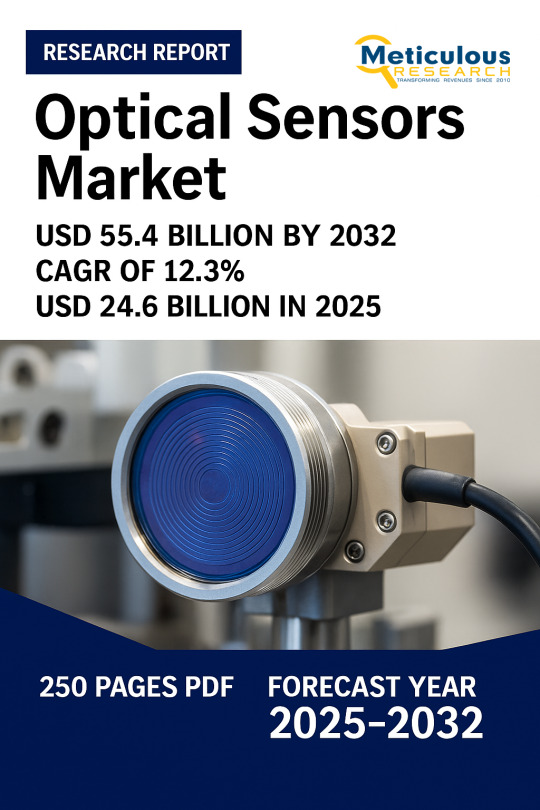
Meticulous Research®—a leading global market research company, published a research report titled ‘Optical Sensors Market—Global Opportunity Analysis and Industry Forecast (2025-2032)’. According to this latest publication, the optical sensors market is projected to reach $55.4 billion by 2032, at a CAGR of 12.3% from 2025 to 2032.
The optical sensors market is experiencing growth driven by the rising demand for optical sensors in consumer electronics and the increasing integration of highly sensitive light sensors in automotive applications. However, limited range and line-of-sight requirements hinder market growth.
In addition, the increasing utilization of optical sensors in healthcare applications and the expanding adoption of advanced light-based technologies for contaminant detection in the food sector present significant growth opportunities for market participants. However, the market also encounters challenges, particularly the high cost associated with advanced optical sensors. Moreover, prominent trends in the optical sensors market include the rise in the adoption of 3D sensing technology in photoelectric sensors and the growing trend of Industry 4.0, IOT, and cloud computing.
Key Players:
The optical sensors market is characterized by a moderately competitive scenario due to the presence of many large- and small-sized global, regional, and local players. The key players operating in the optical sensors market are Broadcom Inc. (U.S.), Renesas Electronics Corporation (Japan), Analog Devices, Inc. (U.S.), Texas Instruments Incorporated (U.S.), TE Connectivity Corporation (Switzerland), Leuze Electronics Pvt. Ltd. (Germany), Honeywell International Inc. (U.S.), Rockwell Automation, Inc. (U.S.), Vishay Intertechnology, Inc. (U.S.), Hamamatsu Photonics, K. K. (Japan), ams-OSRAM AG (Austria), ROHM Co., Ltd. (Japan), ipf electronic gmbh (Germany), SensoPart Industriesensorik GmbH (Germany), and Festo SE & Co. KG (Germany).
The optical sensors market is segmented based on product, type, and end user. The report also evaluates industry competitors and analyzes the optical sensors market at the regional and country levels.
Among the products studied in this report, the photoelectric sensors segment is anticipated to dominate the optical sensors market in 2025. The high demand for photoelectric sensors, which enable non-contact object detection, along with the increasing need to improve system performance and efficiency in high-speed operations, are key factors contributing to the segment's leading position in the optical sensors market.
Among the types studied in this report, the intrinsic optical sensors segment is anticipated to dominate the optical sensors market in 2025. The significant share of intrinsic optical sensors, known for delivering precise measurements of light intensity and wavelength, along with their expanding applications in temperature sensing, pressure monitoring, and chemical detection, are driving the segment's dominance in the optical sensors market.
Among the end users studied in this report, the consumer electronics segment is anticipated to dominate the optical sensors market in 2025. The substantial share of optical sensors in consumer electronics aimed at improving usability and user interaction, combined with the rising demand for smaller, more portable devices and the increasing use of image sensors to enhance camera capabilities for high-resolution photography, are key factors reinforcing the segment's dominance in the optical sensors market.
This research report analyzes major geographies and provides a comprehensive analysis of North America (U.S. and Canada), Europe (Germany, U.K., France, Italy, Spain, Netherlands, Switzerland, Sweden, and Rest of Europe), Asia-Pacific (China, Japan, India, South Korea, Malaysia, Australia & New Zealand, Indonesia, Singapore, and Rest of Asia-Pacific), Latin America (Mexico, Brazil, and Rest of Latin America), and Middle East & Africa (UAE, Saudi Arabia, Israel, and Rest of Middle East & Africa).
Among the geographies studied in this report, North America is anticipated to dominate the optical sensors market in 2025. The expansion in the adoption of smartphones, electric vehicles, and diverse smart home applications, alongside the rising demand for advanced safety systems and vehicle technology and the increased use of optical sensors in healthcare applications within the region, are key factors contributing to the market's dominant position.
Download Sample Report Here @ https://www.meticulousresearch.com/download-sample-report/cp_id=6040
Key Questions Answered in the Report-
What is the value of revenue generated by the product, type, and end user?
At what rate is the global demand for optical sensors projected to grow for the next five to seven years?
What is the historical market size and growth rate for the optical sensors market?
What are the major factors impacting the growth of this market at global and regional levels?
What are the major opportunities for existing players and new entrants in the market?
Which offering segments create major traction in this market?
What are the key geographical trends in this market? Which regions/countries are expected to offer significant growth opportunities for the manufacturers operating in the optical sensors market?
Who are the major players in the optical sensors market? What are their specific product offerings in this market?
What recent developments have taken place in the optical sensors market? What impact have these strategic developments created on the market?
Contact Us: Meticulous Research® Email- [email protected] Contact Sales- +1-646-781-8004 Connect with us on LinkedIn- https://www.linkedin.com/company/meticulous-research
#Optical Sensors Market#Photoelectric Sensors#Fiber Optic Sensors#Image Sensors#Ambient Light & Proximity Sensors#Through-beam Sensors#Retro-reflective Sensors#Biometric &
0 notes
Text
3 notes
·
View notes
Text
I occasionally attend professional get-togethers with my wife, and since she's in a fairly rarefied field the conversation can get very technical and inside baseball. Together with a slight inability to process crowd noise on my part I usually spend my time enjoying my food in a cloud of unparseable muttering.
The last time I attended one of these it was an international affair on top of everything else, so a nice man visiting from Switzerland was the one querying me on what exactly I did. Instead of vaguely saying something about how I work on the computer like usual, I owned up to spending a large percentage of my time reading, writing and making spreadsheets about old comic books, and going into just what I liked about them, and why spreadsheets etc.
And it turns out that the man, Paul, worked in Switzerland but was from Belgium, so there was a lot of excited talk about Hergé and so forth. It was nice! I had a lot of fun talking to Paul! I don't know if baring my soul to a stranger on a whim will have such a good result every time but I might just try again some day!
It’s crazy and fucked up that being yourself is actually the solution.
136K notes
·
View notes
Text
Microsoft Boosts Switzerland’s Digital Future with $400 Million Investment in Cloud and AI Infrastructure
In a landmark move to advance global digital innovation, Microsoft announced a $400 million investment aimed at significantly enhancing Switzerland’s cloud and artificial intelligence (AI) infrastructure. This strategic initiative is designed to strengthen Switzerland’s technological ecosystem, empower startups, and accelerate innovation — positioning the country as a key player in the evolving digital economy.
Strengthening Switzerland’s Digital Backbone: What Microsoft’s $400 Million Investment Entails
Microsoft’s commitment to invest $400 million in Switzerland focuses on upgrading the country’s cloud computing and AI infrastructure, a critical foundation for the digital economy. The investment is set to fund state-of-the-art data centers, cutting-edge AI research, and advanced cloud services tailored to meet growing business demands. By expanding its local data center footprint, Microsoft plans to offer Swiss enterprises faster, more secure, and more reliable cloud solutions — crucial for industries such as finance, healthcare, and manufacturing that rely on high data privacy standards.

This initiative is a part of Microsoft’s broader global strategy to build localized infrastructure hubs that meet stringent data sovereignty and security requirements while driving digital transformation. By investing heavily in Switzerland, Microsoft acknowledges the country’s reputation for innovation, stability, and regulatory rigor, making it an ideal location to pilot and scale advanced digital services.
Timeline and Vision: When and How Microsoft Plans to Deploy Its Swiss Digital Infrastructure
The rollout of Microsoft’s investment began in early 2025, with phased expansion planned over the next three to five years. The initial phase focuses on establishing new Azure data centers equipped with the latest technology to support AI workloads and cloud storage. Following this, Microsoft intends to launch collaborative innovation hubs designed to bring together startups, academic institutions, and industry leaders to co-develop AI and cloud-based solutions.
This timeline reflects Microsoft’s deliberate approach to balancing rapid technological deployment with compliance to Swiss regulations, including data protection laws and environmental standards. The long-term vision emphasizes creating an ecosystem where cloud computing powers not only business efficiency but also fosters sustainable innovation and economic growth across Switzerland.
The Catalyst: Why Microsoft Chose Switzerland and Its Strategic Importance
Switzerland’s unique combination of robust privacy laws, strong financial sector, and thriving startup ecosystem make it an attractive destination for Microsoft’s major investment. By enhancing local cloud infrastructure, Microsoft addresses a growing demand from Swiss organizations for secure, compliant, and performant digital services that align with European Union data sovereignty policies.
Moreover, the country’s strategic location in Europe provides an optimal hub for regional expansion, allowing Microsoft to serve not only Swiss clients but also neighboring countries with reliable cloud and AI resources. The investment supports Switzerland’s ambition to become a leader in digital transformation, ensuring it remains competitive in the global tech landscape.
Business Strategies Behind the Move: How Microsoft’s Investment Supports Global and Local Enterprises
At its core, Microsoft’s $400 million investment is a calculated business strategy designed to accelerate digital adoption among Swiss businesses and startups. By enhancing cloud infrastructure locally, Microsoft enables companies to reduce latency, improve data security, and innovate faster with AI-powered solutions. This directly translates into improved operational efficiency, cost savings, and enhanced customer experiences across multiple sectors.
For startups and scale-ups, the investment means access to powerful AI tools and cloud resources that can level the playing field against larger global competitors. Microsoft’s innovation hubs aim to provide mentoring, resources, and partnerships that drive entrepreneurship and job creation. These efforts align with Microsoft’s broader goal of fostering inclusive growth and digital resilience worldwide.
Global Impact: How This Investment Benefits People and Economies Beyond Switzerland
While centered in Switzerland, the ripple effects of Microsoft’s investment will benefit people and businesses around the world. By pioneering secure, high-performance cloud and AI infrastructure, Switzerland can serve as a blueprint for other countries seeking to modernize their digital capabilities. Enhanced cloud access fosters innovation that can accelerate healthcare breakthroughs, financial services efficiency, and environmental sustainability initiatives globally.
Read More : Microsoft Boosts Switzerland’s Digital Future with $400 Million Investment in Cloud and AI Infrastructure
#Sure! Here are relevant comma-separated tags for your topic:#**Microsoft#Switzerland#cloud computing#AI infrastructure#digital transformation#tech investment#artificial intelligence#data centers#cloud services#European tech#digital future#Microsoft Azure#tech innovation#AI expansion#\$400 million investment**
0 notes
Text
Phd or Postdoc in Switzerland for International Students: On Swiss Government Excellence Scholarships
Do you have a fresh master or PhD and are you considering Phd or Postdoc in Switzerland? The Swiss Government Excellence Scholarship offers young researchers from around the world who have completed a master’s degree or PhD the opportunity to start or continue their research careers in Switzerland. The scholarship supports research endeavors for a period of one year, or up to three years for…

View On WordPress
#Big Data#Cloud Computing#Digital Decision Making#Distributed Systems#fellowship#Human Behaviour Informatics#internet of things#IoT#PhD#Post-Doc#Service Oriented Architecture#Swiss#Switzerland#Virtual Reality
0 notes
Text
Revenue Assurance Market Size, Share, Trends, Demand, Growth, Challenges and Competitive Outlook
Global Revenue Assurance Market - Size, Share, Demand, Industry Trends and Opportunities
Global Revenue Assurance Market, By Component (Software, Services), Deployment Model (On-premise, Cloud), Country (U.S., Canada, Mexico, Brazil, Argentina, Rest of South America, Germany, Italy, U.K., France, Spain, Netherlands, Belgium, Switzerland, Turkey, Russia, Rest of Europe, Japan, China, India, South Korea, Australia, Singapore, Malaysia, Thailand, Indonesia, Philippines, Rest of Asia-Pacific, Saudi Arabia, U.A.E, South Africa, Egypt, Israel, Rest of Middle East and Africa) Industry Trends
Access Full 350 Pages PDF Report @
**Segments**
- **Component:** The revenue assurance market is segmented based on components into software and services. The software segment is expected to hold a significant market share due to the increasing need for advanced solutions to manage revenue assurance processes efficiently. On the other hand, the services segment is projected to grow as businesses seek expert assistance in implementing revenue assurance strategies.
- **Deployment Model:** Based on deployment models, the market is classified into on-premises and cloud. The cloud deployment model is witnessing substantial growth as organizations embrace cloud computing technologies for cost-effectiveness and scalability. However, the on-premises segment remains relevant for enterprises with specific security and compliance requirements.
- **Industry Vertical:** The revenue assurance market is further segmented by industry verticals such as telecom, BFSI, healthcare, retail, and others. The telecom sector is a key adopter of revenue assurance solutions to mitigate revenue leakages and enhance profitability. Additionally, the BFSI industry is increasingly investing in advanced technologies to ensure accurate revenue management and regulatory compliance.
- **Region:** Geographically, the global revenue assurance market is segmented into North America, Europe, Asia Pacific, Latin America, and Middle East & Africa. North America dominates the market due to the presence of major players and early adoption of revenue assurance technologies. Asia Pacific is poised for rapid growth driven by increasing digitization initiatives and expanding telecom infrastructure.
**Market Players**
- **Accenture:** Accenture offers comprehensive revenue assurance solutions to help businesses optimize revenue streams and minimize risks. Their expertise in analytics and digital technologies enables effective revenue management strategies.
- **IBM Corporation:** IBM provides advanced revenue assurance software and services tailored to meet the evolving needs of modern businesses. Their solutions incorporate artificial intelligence and automation for efficient revenue tracking and analysis.
- **Tech Mahindra:** Tech Mahindra specializes in end-to-end revenue assurance services, including revenue leakage detection, revenue reconciliation, and fraud management. Their industry-specific approach ensures customized solutions for enhanced revenue protection.
- **Amdocs:** Amdocs offers revenue assurance platforms that combine data analytics and machine learning capabilities to proactively identify revenue risks. Their solutions empower enterprises to maintain revenue integrity and drive business growth.
The global revenue assurance market is witnessing substantial growth attributed to the increasing focus on optimizing revenue streams and ensuring financial transparency. Market players are continuously innovating to deliver advanced solutions that address revenue leakage challenges across diverse industry verticals. With the rising adoption of cloud-based technologies and data-driven insights, the revenue assurance market is projected to expand further in the upcoming years.
https://www.databridgemarketresearch.com/reports/global-revenue-assurance-marketThe global revenue assurance market is experiencing a significant transformation driven by technological advancements and evolving business needs. One of the emerging trends in the market is the integration of artificial intelligence (AI) and machine learning (ML) technologies to enhance revenue management processes. AI and ML capabilities enable organizations to automate revenue tracking, detect anomalies, and predict potential revenue risks accurately. By leveraging these advanced technologies, businesses can proactively address revenue leakage issues and optimize revenue streams more effectively.
Another crucial factor influencing the revenue assurance market is the increasing emphasis on regulatory compliance and financial transparency. With regulatory requirements becoming more stringent across industries, companies are investing in robust revenue assurance solutions to ensure adherence to compliance standards. By implementing sophisticated revenue assurance tools, organizations can enhance their financial integrity, reduce the risk of revenue leakages, and maintain regulatory compliance consistently.
Furthermore, the growing demand for industry-specific revenue assurance solutions is driving market players to develop customized offerings tailored to address the unique needs of different sectors. Industries such as telecommunications, banking, healthcare, and retail require specialized revenue assurance strategies to mitigate revenue risks specific to their business operations. Consequently, solution providers are focusing on designing industry-specific solutions that cater to the distinct challenges and opportunities within each vertical.
Moreover, the shift towards cloud-based deployment models is reshaping the revenue assurance market landscape by offering scalability, flexibility, and cost-efficiency to organizations. Cloud technologies enable businesses to access revenue assurance solutions on a subscription basis, reducing upfront infrastructure costs and enabling quicker implementation. By adopting cloud-based revenue assurance platforms, companies can leverage real-time data analytics, seamless integration, and remote access capabilities to streamline their revenue management processes effectively.
Overall, the global revenue assurance market is poised for continued growth as organizations across sectors recognize the importance of optimizing revenue streams, ensuring financial transparency, and mitigating revenue risks. Market players are focusing on innovation, strategic partnerships, and customer-centric approaches to meet the evolving needs of businesses in a dynamic economic environment. As the market evolves, we can expect to see further advancements in technology, regulatory compliance standards, and industry-specific solutions that will drive the expansion of the revenue assurance market in the foreseeable future.**Segments**
Global Revenue Assurance Market, By Component (Software, Services), Deployment Model (On-premise, Cloud), Country (U.S., Canada, Mexico, Brazil, Argentina, Rest of South America, Germany, Italy, U.K., France, Spain, Netherlands, Belgium, Switzerland, Turkey, Russia, Rest of Europe, Japan, China, India, South Korea, Australia, Singapore, Malaysia, Thailand, Indonesia, Philippines, Rest of Asia-Pacific, Saudi Arabia, U.A.E, South Africa, Egypt, Israel, Rest of Middle East and Africa) Industry Trends and Forecast to 2028
The revenue assurance market segmentation based on components into software and services shows promising growth opportunities. The software segment is expected to dominate the market due to the rising demand for sophisticated solutions to efficiently manage revenue assurance processes. Businesses are increasingly adopting advanced software tools to streamline revenue management and minimize risks. On the other hand, the services segment is projected to witness significant growth as companies seek expert guidance in implementing revenue assurance strategies tailored to their specific needs.
In terms of deployment models, the market is segmented into on-premises and cloud solutions. The cloud deployment model is experiencing substantial growth as organizations leverage cloud technologies for cost-effective and scalable revenue assurance solutions. Cloud-based platforms offer flexibility, real-time data analytics, and remote access capabilities, making them an attractive choice for businesses looking to enhance their revenue management processes. However, the on-premises segment remains relevant for enterprises with stringent security and compliance requirements, highlighting the importance of customizable deployment options in the revenue assurance market.
The revenue assurance market segmented by industry verticals such as telecom, BFSI, healthcare, retail, and others showcases diverse opportunities for revenue optimization and risk mitigation. The telecom sector emerges as a key adopter of revenue assurance solutions to combat revenue leakages and enhance profitability through streamlined processes. Additionally, the BFSI industry is increasing its investments in advanced revenue management technologies to ensure accurate financial reporting and regulatory compliance, driving the demand for innovative revenue assurance solutions tailored to the specific needs of each sector.
Geographically, the global revenue assurance market is segmented into key regions such as North America, Europe, Asia Pacific, Latin America, and Middle East & Africa. North America leads the market, driven by the presence of major industry players and early adoption of revenue assurance technologies. In contrast, Asia Pacific is poised for rapid growth fueled by increasing digitization efforts and expanding telecom infrastructure, presenting lucrative opportunities for market expansion in the region.
The integration of artificial intelligence (AI) and machine learning (ML) technologies is a notable trend shaping the revenue assurance market, enabling automation of revenue tracking, anomaly detection, and prediction of revenue risks with greater accuracy. AI and ML capabilities empower organizations to proactively address revenue leakage issues and optimize revenue streams effectively, driving efficiency and transparency in revenue management processes. Moreover, the emphasis on regulatory compliance and financial transparency is spurring the adoption of advanced revenue assurance solutions to ensure adherence to compliance standards and mitigate revenue risks effectively across industries.
As the revenue assurance market evolves, industry-specific solutions tailored to unique verticals' needs are gaining prominence. Customized revenue assurance strategies for sectors such as telecommunications, banking, healthcare, and retail are addressing specific revenue challenges and opportunities, fueling demand for specialized solutions in the market. Additionally, the shift towards cloud-based deployment models is reshaping the revenue assurance landscape by offering scalability, flexibility, and cost-efficiency to organizations, enabling real-time data analytics and seamless integration for streamlined revenue management processes.
In conclusion, the global revenue assurance market is set for continued growth as businesses prioritize revenue optimization, financial transparency, and risk mitigation. Market players are ramping up innovation, strategic partnerships, and customer-centric approaches to meet evolving business needs and regulatory requirements. The integration of advanced technologies, industry-specific solutions, and cloud-based deployment models are driving market expansion and shaping the future of revenue assurance, positioning the market for robust growth in the forecast period.
Highlights of TOC:
Chapter 1: Market overview
Chapter 2: Global Revenue Assurance Market
Chapter 3: Regional analysis of the Global Revenue Assurance Market industry
Chapter 4: Revenue Assurance Market segmentation based on types and applications
Chapter 5: Revenue analysis based on types and applications
Chapter 6: Market share
Chapter 7: Competitive Landscape
Chapter 8: Drivers, Restraints, Challenges, and Opportunities
Chapter 9: Gross Margin and Price Analysis
Core Objective of Revenue Assurance Market:
Every firm in the Revenue Assurance Market has objectives but this market research report focus on the crucial objectives, so you can analysis about competition, future market, new products, and informative data that can raise your sales volume exponentially.
Size of the Revenue Assurance Market and growth rate factors.
Important changes in the future Revenue Assurance Market.
Top worldwide competitors of the Market.
Scope and product outlook of Revenue Assurance Market.
Developing regions with potential growth in the future.
Tough Challenges and risk faced in Market.
Global Revenue Assurance top manufacturers profile and sales statistics.
Regional Analysis for Revenue Assurance Market:
APAC (Japan, China, South Korea, Australia, India, and Rest of APAC; Rest of APAC is further segmented into Malaysia, Singapore, Indonesia, Thailand, New Zealand, Vietnam, and Sri Lanka)
Europe (Germany, UK, France, Spain, Italy, Russia, Rest of Europe; Rest of Europe is further segmented into Belgium, Denmark, Austria, Norway, Sweden, The Netherlands, Poland, Czech Republic, Slovakia, Hungary, and Romania)
North America (U.S., Canada, and Mexico)
South America (Brazil, Chile, Argentina, Rest of South America)
MEA (Saudi Arabia, UAE, South Africa)
Browse Trending Reports:
Bubble Wrap Packaging Market Acute Cholecystitis Market Composite Packaging Market Sprinkler Gun Market Computational Creativity Market Energy Drinks Packaging Market Semi-Finished Pastry Ingredients Market Veterinary Lasers Market Subsea Thermal Insulation Materials Market Well Intervention Market Automotive Door Seal Market Desmutting Agent Market
About Data Bridge Market Research:
Data Bridge set forth itself as an unconventional and neoteric Market research and consulting firm with unparalleled level of resilience and integrated approaches. We are determined to unearth the best market opportunities and foster efficient information for your business to thrive in the market. Data Bridge endeavors to provide appropriate solutions to the complex business challenges and initiates an effortless decision-making process.
Contact Us:
Data Bridge Market Research
US: +1 614 591 3140
UK: +44 845 154 9652
APAC : +653 1251 975
Email: [email protected]
0 notes
Text
Geographic Information System (GIS) Software Market Size, Share, Trends, Demand, Growth, Challenges and Competitive Analysis
"Global Geographic Information System (GIS) Software Market - Size, Share, Demand, Industry Trends and Opportunities
Global Geographic Information System (GIS) Software Market By Component (Hardware and Software), Project Size (Small, Medium and Large), Organization (Small and Medium Sized Enterprises and Large Enterprises), Function (Mapping, Surveying, Telematics Navigation and Location Based Services), End User (Agriculture, Oil and Gas, Construction, Mining, Transportation, Utilities, and Others), Country (U.S., Canada, Mexico, Brazil, Argentina, Rest of South America, Germany, France, Italy, U.K., Belgium, Spain, Russia, Turkey, Netherlands, Switzerland, Rest of Europe, Japan, China, India, South Korea, Australia, Singapore, Malaysia, Thailand, Indonesia, Philippines, Rest of Asia-Pacific, U.A.E, Saudi Arabia, Egypt, South Africa, Israel, Rest of Middle East and Africa) Industry Trends
Access Full 350 Pages PDF Report @
**Segments**
- **Hardware**: The hardware segment in the GIS software market includes the physical components necessary for the implementation of Geographic Information Systems. This includes GPS devices, data collection tools, desktop computers, servers, and storage devices. The demand for hardware in the GIS software market is driven by the need for high-performance computing and data processing capabilities to handle large datasets efficiently.
- **Software**: The software segment comprises the various GIS applications and platforms that enable users to visualize, analyze, and interpret geospatial data. These software tools range from desktop GIS applications to web-based mapping platforms and cloud-based GIS services. The software segment is experiencing rapid growth due to the increasing adoption of location-based services across various industries.
- **Services**: The services segment in the GIS software market includes consulting, training, system integration, and support services provided by GIS vendors and third-party service providers. These services help organizations effectively implement and utilize GIS software solutions to address their specific business needs. The services segment is critical for ensuring the successful deployment and maintenance of GIS systems.
**Market Players**
- **Esri**: Esri is a leading provider of GIS software and services, offering a wide range of products for mapping, spatial analysis, and location intelligence. The company's ArcGIS platform is used by organizations worldwide for various applications, including urban planning, natural resource management, and emergency response.
- **Hexagon AB**: Hexagon AB is a global technology company that offers a comprehensive suite of geospatial solutions, including GIS software, remote sensing tools, and surveying instruments. The company's geospatial division provides software products such as ERDAS IMAGINE and GeoMedia for geospatial data processing and analysis.
- **Trimble Inc.**: Trimble Inc. is a leading provider of advanced positioning solutions, including GPS technology and GIS software for surveying, mapping, and precision agriculture applications. The company's product portfolio includes software products like Trimble Business Center and Trimble eCognition for geosEsri, Hexagon AB, and Trimble Inc. are key players in the GIS software market, each offering a unique set of products and services to cater to the diverse needs of organizations across industries. Esri, with its ArcGIS platform, stands out for its comprehensive suite of mapping and spatial analysis tools that have become the industry standard for GIS applications. The company's focus on innovation and continuous enhancement of its offerings has cemented its position as a market leader and trusted partner for organizations seeking robust geospatial solutions.
Hexagon AB, on the other hand, brings a strong emphasis on remote sensing and surveying instruments to the GIS software market. Its geospatial division, with products like ERDAS IMAGINE and GeoMedia, caters to the advanced data processing and analysis requirements of industries such as agriculture, environmental monitoring, and infrastructure planning. Hexagon AB's focus on providing end-to-end geospatial solutions has positioned it as a key player in the industry, known for its technological expertise and commitment to customer satisfaction.
Trimble Inc. differentiates itself in the GIS software market by offering advanced positioning solutions integrated with GIS software for applications in surveying, mapping, and precision agriculture. The company's software products such as Trimble Business Center and Trimble eCognition are designed to streamline geospatial data analysis and provide actionable insights for users in various sectors. Trimble Inc.'s strong presence in precision technology and spatial data management makes it a preferred choice for organizations looking to leverage GIS software for improved decision-making and operational efficiency.
Overall, the GIS software market is witnessing significant growth driven by the increasing adoption of location-based services across industries such as construction, transportation, utilities, and government. As organizations continue to recognize the value of geospatial data in enhancing decision-making processes and improving operational workflows, the demand for advanced GIS software solutions is expected to rise. Market players like Esri, Hexagon AB, and Trimble Inc. are well-positioned to capitalize on**Segments:**
- **Global Geographic Information System (GIS) Software Market By Component (Hardware and Software) - **Project Size (Small, Medium and Large) - **Organization (Small and Medium Sized Enterprises and Large Enterprises) - **Function (Mapping, Surveying, Telematics Navigation and Location Based Services) - **End User (Agriculture, Oil and Gas, Construction, Mining, Transportation, Utilities, and Others) - **Country (U.S., Canada, Mexico, Brazil, Argentina, Rest of South America, Germany, France, Italy, U.K., Belgium, Spain, Russia, Turkey, Netherlands, Switzerland, Rest of Europe, Japan, China, India, South Korea, Australia, Singapore, Malaysia, Thailand, Indonesia, Philippines, Rest of Asia-Pacific, U.A.E, Saudi Arabia, Egypt, South Africa, Israel, Rest of Middle East and Africa) Industry Trends and Forecast to 2028
The GIS software market is undergoing significant growth globally due to the rising demand for location-based services across various industries. The hardware segment, which includes essential physical components for GIS implementation such as GPS devices and servers, is driven by the need for high-performance computing and efficient data processing capabilities. The software segment is experiencing rapid expansion with a wide range of GIS applications and platforms enabling effective visualization, analysis, and interpretation of geospatial data. The services segment, encompassing consulting, training, and support services, plays a crucial role in ensuring the successful implementation and utilization
Key points covered in the report: -
The pivotal aspect considered in the global Geographic Information System (GIS) Software Market report consists of the major competitors functioning in the global market.
The report includes profiles of companies with prominent positions in the global market.
The sales, corporate strategies and technical capabilities of key manufacturers are also mentioned in the report.
The driving factors for the growth of the global Geographic Information System (GIS) Software Market are thoroughly explained along with in-depth descriptions of the industry end users.
The report also elucidates important application segments of the global market to readers/users.
This report performs a SWOT analysis of the market. In the final section, the report recalls the sentiments and perspectives of industry-prepared and trained experts.
The experts also evaluate the export/import policies that might propel the growth of the Global Geographic Information System (GIS) Software Market.
The Global Geographic Information System (GIS) Software Market report provides valuable information for policymakers, investors, stakeholders, service providers, producers, suppliers, and organizations operating in the industry and looking to purchase this research document.
TABLE OF CONTENTS
Part 01: Executive Summary
Part 02: Scope of the Report
Part 03: Research Methodology
Part 04: Market Landscape
Part 05: Pipeline Analysis
Part 06: Market Sizing
Part 07: Five Forces Analysis
Part 08: Market Segmentation
Part 09: Customer Landscape
Part 10: Regional Landscape
Part 11: Decision Framework
Part 12: Drivers and Challenges
Part 13: Market Trends
Part 14: Vendor Landscape
Part 15: Vendor Analysis
Part 16: Appendix
Countries Studied:
North America (Argentina, Brazil, Canada, Chile, Colombia, Mexico, Peru, United States, Rest of Americas)
Europe (Austria, Belgium, Denmark, Finland, France, Germany, Italy, Netherlands, Norway, Poland, Russia, Spain, Sweden, Switzerland, United Kingdom, Rest of Europe)
Middle-East and Africa (Egypt, Israel, Qatar, Saudi Arabia, South Africa, United Arab Emirates, Rest of MEA)
Asia-Pacific (Australia, Bangladesh, China, India, Indonesia, Japan, Malaysia, Philippines, Singapore, South Korea, Sri Lanka, Thailand, Taiwan, Rest of Asia-Pacific)
Browse Trending Reports:
Empty Capsules Market Temperature Sensor Market Fusion Splicer Market Methylene Diphenyl Diisocyanate (MDI), Toluene Diisocyanate (TDI) and Polyurethane Market Laser Cleaning Market Flotation Reagents Market Sugar Confectionery Market Wipes Market Monorail Market Geographic Information System (GIS) Software Market MLOPs Market Feed Flavors and Sweeteners Market
About Data Bridge Market Research:
Data Bridge set forth itself as an unconventional and neoteric Market research and consulting firm with unparalleled level of resilience and integrated approaches. We are determined to unearth the best market opportunities and foster efficient information for your business to thrive in the market. Data Bridge endeavors to provide appropriate solutions to the complex business challenges and initiates an effortless decision-making process.
Contact Us:
Data Bridge Market Research
US: +1 614 591 3140
UK: +44 845 154 9652
APAC : +653 1251 975
Email: [email protected]"
0 notes
Text
AI in Drug Discovery Market Forecast to Witness Explosive Growth Amid Rising R&D Investments

Market Overview
The AI in Drug Discovery Market is experiencing significant growth as pharmaceutical and biotech industries embrace artificial intelligence to streamline and enhance their drug development processes. The market is characterized by a convergence of life sciences and advanced technologies, aiming to accelerate the traditionally lengthy and costly drug discovery process. From target identification to post-market monitoring, AI tools are now being used to analyze vast datasets, predict molecular behavior, and support critical decisions across all stages of drug development.
The market is segmented by molecule type—such as small molecules, large molecules, biologics, peptides, nucleic acids, antibodies, and vaccines—each of which benefits from AI-driven techniques to improve discovery efficiency. With an increasing demand for precision medicine and cost-effective solutions, AI in drug discovery has emerged as a transformative force in healthcare innovation.
Click to Request a Sample of this Report for Additional Market Insights: https://www.globalinsightservices.com/request-sample/?id=GIS24723
Market Dynamics
Key drivers fueling the AI in drug discovery market include the rising costs of traditional drug development, increasing prevalence of complex diseases, and the need for faster time-to-market for new therapies. AI technologies like machine learning, deep learning, and natural language processing are enabling researchers to mine scientific literature, clinical trial data, and genomic databases at unprecedented speeds.
Moreover, the integration of cloud computing, computer vision, and robotics into R&D pipelines is driving automation and scalability in preclinical and clinical research. These technological advancements are helping pharmaceutical companies identify drug candidates more accurately and reduce the probability of failure during trials. However, challenges such as data privacy concerns, regulatory uncertainties, and high implementation costs still act as restraints for market adoption.
Key Players Analysis
The market is competitive and evolving, with several key players contributing to its growth. Major pharmaceutical and biotechnology companies are increasingly collaborating with tech firms and AI startups to enhance their research capabilities. Notable companies include IBM Watson Health, Insilico Medicine, Exscientia, Atomwise, and BenevolentAI. These firms are investing in AI-driven platforms, databases, and tools that support drug screening, lead optimization, and predictive modeling.
In addition to product developers, service providers specializing in consulting, integration, support, and maintenance are playing a crucial role in enabling organizations to adopt AI solutions effectively. Their contributions ensure smoother deployment and efficient management of complex AI infrastructures in life sciences environments.
Regional Analysis
Geographically, North America leads the global AI in drug discovery market due to strong R&D investments, advanced healthcare infrastructure, and the presence of key market players. The United States, in particular, is home to leading pharmaceutical companies and AI research institutions that drive innovation in this space.
Europe follows closely, with countries like the United Kingdom, Germany, and Switzerland making significant strides in AI-enabled drug development through public-private partnerships and government-funded initiatives.
Asia Pacific is also emerging as a lucrative region, especially with the growing investments in biotechnology across China, India, and Japan. These countries are ramping up AI research efforts and fostering collaborations between tech firms and pharmaceutical companies.
Recent News & Developments
Recent developments in the AI in drug discovery market indicate strong momentum. Companies like Exscientia and Insilico Medicine have successfully advanced AI-designed molecules into clinical trials, a milestone that highlights AI's growing impact on early-stage drug discovery.
Additionally, several collaborations and funding rounds are making headlines. For instance, pharmaceutical giants are entering multi-million-dollar agreements with AI firms to develop novel compounds. Government initiatives across the U.S. and Europe are also supporting AI-driven innovation through grants and regulatory guidance, enabling a more conducive environment for AI adoption in life sciences.
Browse Full Report @ https://www.globalinsightservices.com/reports/ai-in-drug-discovery-market/
Scope of the Report
This report covers a comprehensive analysis of the AI in Drug Discovery Market, segmented across various components including hardware, software, and services. It explores applications such as target identification, drug screening, and clinical trials, and examines deployment models like cloud-based, on-premises, and hybrid systems.
By focusing on end users—such as pharmaceutical companies, biotechnology firms, research institutions, and contract research organizations—the report outlines how different stakeholders are leveraging AI at various drug development stages, from discovery to post-market surveillance. It also offers insights into technological trends like deep learning, robotics, and computer vision, setting the stage for future innovations in AI-powered drug discovery.
In summary, the AI in drug discovery market is poised for substantial growth, driven by technological innovation, increasing disease burden, and the global push for more efficient and cost-effective therapeutic solutions.
Discover Additional Market Insights from Global Insight Services:
Wearable Pain Management Devices Market: https://www.globalinsightservices.com/reports/wearable-pain-management-devices-market/
Pharmaceutical Rubber Stoppers and Seals Market: https://www.globalinsightservices.com/reports/pharmaceutical-rubber-stoppers-and-seals-market/
Wearable Breast Pumps Market: https://www.globalinsightservices.com/press-releases/wearable-breast-pumps-market/
Eyewear Market: https://www.globalinsightservices.com/reports/eyewear-market/
0 notes